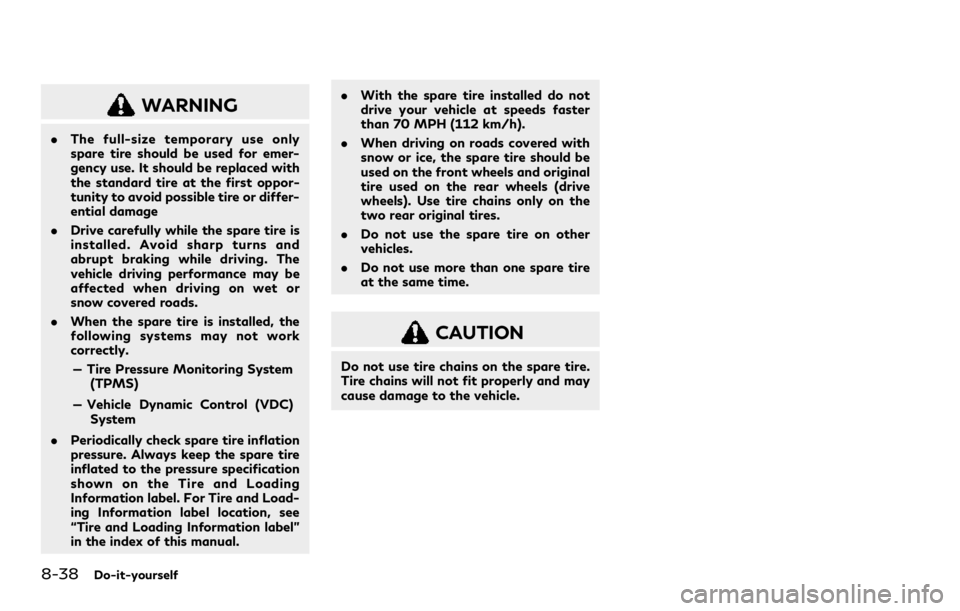Tire chains INFINITI QX80 2021 User Guide
[x] Cancel search | Manufacturer: INFINITI, Model Year: 2021, Model line: QX80, Model: INFINITI QX80 2021Pages: 529, PDF Size: 2.05 MB
Page 424 of 529

8 Do-it-yourself
Maintenance precautions ............................................... 8-2
Engine compartment check locations ......................... 8-3VK56VD engine model .............................................. 8-3
Engine cooling system ..................................................... 8-4 Checking engine coolant level ................................. 8-5
Changing engine coolant .......................................... 8-5
Engine oil ........................................................................\
..... 8-6 Checking engine oil level ........................................... 8-6
Changing engine oil and filter .................................. 8-6
Automatic Transmission Fluid (ATF) .......................... 8-8
Power steering fluid ......................................................... 8-8
Brake fluid ........................................................................\
... 8-9 Brake fluid ..................................................................... 8-9
Window washer fluid ................................................... 8-10
Battery ........................................................................\
....... 8-11 Jump starting ............................................................. 8-12
Variable voltage control system ................................. 8-13
Drive belts ........................................................................\
. 8-13
Spark plugs ....................................................................... 8-14 Replacing spark plugs .............................................. 8-14
Air cleaner ........................................................................\
. 8-14 Windshield wiper blades .............................................. 8-15
Cleaning ..................................................................... 8-15
Replacing ................................................................... 8-16
Rear window wiper blades .......................................... 8-16
Brakes ........................................................................\
........ 8-17 Self-adjusting brakes ............................................. 8-17
Brake pad wear warning ....................................... 8-17
Brake booster ........................................................... 8-17
Fuses ........................................................................\
.......... 8-18 Engine compartment .............................................. 8-18
Passenger compartment ...................................... 8-20
Intelligent Key battery replacement ......................... 8-21
Lights ........................................................................\
......... 8-23
Headlights ................................................................ 8-24
Exterior and interior lights ................................... 8-24
Wheels and tires ............................................................. 8-27
Tire pressure ............................................................. 8-27
Tire labeling .............................................................. 8-31
Types of tires ........................................................... 8-33
Tire chains ................................................................ 8-34
Changing wheels and tires ................................... 8-35
Page 457 of 529

8-34Do-it-yourself
year, including snowy and icy road condi-
tions. All Season tires are identified by ALL
SEASON and/or M&S (Mud and Snow) on
the tire sidewall. Snow tires have better
snow traction than All Season tires and may
be more appropriate in some areas.
Summer tires
INFINITI specifies summer tires on some
models to provide superior performance on
dry roads. Summer tire performance is
substantially reduced in snow and ice. Sum-
mer tires do not have the tire traction rating
M&S on the tire sidewall.
If you plan to operate your vehicle in snowy
or icy conditions, INFINITI recommends the
use of SNOW tires or ALL SEASON tires on
all four wheels.
Snow tires
If snow tires are needed, it is necessary to
select tires equivalent in size and load rating
to the original equipment tires. If you do not,
it can adversely affect the safety and
handling of your vehicle.
Generally, snow tires will have lower speed
ratings than factory equipped tires and may
not match the potential maximum vehicle
speed. Never exceed the maximum speed
rating of the tire.
If you install snow tires, they must be thesame size, brand, construction and tread
pattern on all four wheels.
For additional traction on icy roads, studded
tires may be used. However, some U.S.
states and Canadian provinces prohibit their
use. Check local, state and provincial laws
before installing studded tires. Skid and
traction capabilities of studded snow tires,
on wet or dry surfaces, may be poorer than
that of non-studded snow tires.
TIRE CHAINS
Use of tire chains may be prohibited accord-
ing to location. Check the local laws before
installing tire chains. When installing tire
chains, make sure they are the proper size
for the tires on your vehicle and are installed
according to the chain manufacturer’s sug-
gestions.
Use only SAE Class S chains. Class
“S” chains are used on vehicles with re-
stricted tire to vehicle clearance. Vehicles
that can use Class “S” chains are designed to
meet the SAE standard minimum clearances
between the tire and the closest vehicle
suspension or body component required to
accommodate the use of a winter traction
device (tire chains or cables). The minimum
clearances are determined using the factory
equipped tire size. Other types may damage
your vehicle. Use chain tensioners when
recommended by the tire chain manufac-
turer to ensure a tight fit. Loose end links of the tire chain must be secured or removed to
prevent the possibility of whipping action
damage to the fenders or underbody. If
possible, avoid fully loading your vehicle
when using tire chains. In addition, drive at
a reduced speed. Otherwise, your vehicle
may be damaged and/or vehicle handling
and performance may be adversely affected.
Tire chains must be installed only on the
rear wheels and not on the front wheels.
Never install tire chains on the full-size
temporary use only spare tire (if so
equipped).
Do not use tire chains on dry roads. Driving
with tire chains in such conditions can cause
damage to the various mechanisms of the
vehicle due to some overstress.
Page 461 of 529

8-38Do-it-yourself
WARNING
.The full-size temporary use only
spare tire should be used for emer-
gency use. It should be replaced with
the standard tire at the first oppor-
tunity to avoid possible tire or differ-
ential damage
. Drive carefully while the spare tire is
installed. Avoid sharp turns and
abrupt braking while driving. The
vehicle driving performance may be
affected when driving on wet or
snow covered roads.
. When the spare tire is installed, the
following systems may not work
correctly.
— Tire Pressure Monitoring System (TPMS)
— Vehicle Dynamic Control (VDC) System
. Periodically check spare tire inflation
pressure. Always keep the spare tire
inflated to the pressure specification
shown on the Tire and Loading
Information label. For Tire and Load-
ing Information label location, see
“Tire and Loading Information label”
in the index of this manual. .
With the spare tire installed do not
drive your vehicle at speeds faster
than 70 MPH (112 km/h).
. When driving on roads covered with
snow or ice, the spare tire should be
used on the front wheels and original
tire used on the rear wheels (drive
wheels). Use tire chains only on the
two rear original tires.
. Do not use the spare tire on other
vehicles.
. Do not use more than one spare tire
at the same time.
CAUTION
Do not use tire chains on the spare tire.
Tire chains will not fit properly and may
cause damage to the vehicle.
Page 507 of 529

10-26Technical and consumer information
measured reference height when loaded,
the vehicle may handle unpredictably
which could cause a loss of vehicle
control and cause serious personal injury
or property damage.
Sway control device
Sudden maneuvers, wind gusts and buffet-
ing caused by other vehicles can affect
trailer handling. Sway control devices may
be used to help control these affects. If you
choose to use one, contact a reputable
trailer hitch supplier to make sure the sway
control device will work with the vehicle,
hitch, trailer and the trailer’s brake system.
Follow the instructions provided by the
manufacturer for installing and using the
sway control device.
Class I hitch
Class I trailer hitch equipment (receiver, ball
mount and hitch ball) can be used to tow
trailers of a maximum weight of 2,000 lb
(907 kg).
Class II hitch
Class II trailer hitch equipment (receiver, ball
mount and hitch ball) can be used to tow
trailers of a maximum weight of 3,500 lb
(1,588 kg).
Class III hitch
Class III trailer hitch equipment (receiver, ball
mount and hitch ball) can be used to tow
trailers of a maximum weight of 5,000 lb
(2,267 kg).
Class IV hitch
Class IV trailer hitch equipment (receiver, ball
mount and hitch ball) can be used to tow
trailers of a maximum weight of 10,000 lb
(4,545 kg). A weight distributing hitch
should be used to tow trailers that weigh
over 5,000 lb (2,267 kg).
Your vehicle may be equipped with Class IV
trailer hitch equipment that has a 10,000 lb
(4,545 kg) maximum weight rating, but your
vehicle is only capable of towing the max-
imum trailer weights shown in the “Towing
Load/Specification” chart earlier in this
section.
CAUTION
.Do not use axle-mounted hitches.
. Do not modify the vehicle exhaust
system, brake system, etc.
. Do not attach any additional hitches
to your vehicle because a hitch is
already mounted to your vehicle frame.
Tire pressures
.
When towing a trailer, inflate the
vehicle tires to the recommended
cold tire pressure indicated on the
Tire and Loading Information la-
bel.
. Trailer tire condition, size, load
rating and proper inflation pres-
sure should be in accordance with
the trailer and tire manufacturers’
specifications.
Safety chains
Always use a suitable chain between your
vehicle and the trailer. The safety chains
should be crossed and should be attached to
the hitch, not to the vehicle bumper or axle.
Be sure to leave enough slack in the chains to
permit turning corners.
Page 524 of 529

TirePressure, Low tire pressure
warning light ................................................... 2-16
Tires
Flat tire ............................................................... 6-3
Low tire pressure warning system ............. 5-5
Tire and Loading
information label ............................. 8-28, 10-13
Tire chains ....................................................... 8-34
Tire dressing ...................................................... 7-4
Tire pressure ................................................... 8-27
Tire pressure monitoring
system (TPMS) ........................................ 5-5, 6-3
Tire rotation .................................................... 8-35
Types of tires .................................................. 8-33
Uniform tire quality grading .................... 10-31
Wheel/tire size ............................................... 10-9
Wheels and tires ............................................ 8-27
Top
Tether strap child restraints ....................... 1-36
TOW mode .......................................................... 5-122
TOW mode switch .............................................. 2-53
Towing Flat towing ................................................... 10-31
Tow truck towing .......................................... 6-15
Towing a trailer ........................................... 10-19
Towing safety .............................................. 10-23
TPMS, Tire pressure monitoring system ......... 5-5
TPMS with Tire Inflation Indicator ............. 5-7
TPMS, Tire pressure warning system .............. 6-3
Trailer towing ..................................................... 10-19 Transceiver
HomeLink®
Universal Transceiver ....................... 2-75, 2-79
Transmission
Automatic Transmission Fluid (ATF) ......... 8-8
Driving with automatic transmission ....... 5-18
Transmission shift lever lock release ....... 5-21
Transmitter (See remote keyless
entry system) ........................................................ 3-15
Traveling or registering your vehicle in
another country ................................................. 10-11
Trip computer ....................................................... 2-31
Trip odometer ....................................................... 2-31
Turn signal switch ............................................... 2-46
U
Underbody cleaning ............................................... 7-3
Uniform tire quality grading ........................... 10-31
USB (Universal Serial Bus)
charging connector ............................................. 2-58
V
Vanity mirror ......................................................... 3-39
Vanity mirror lights ............................................. 2-74
Variable voltage control system ..................... 8-13
Vehicle Dimensions ................................................... 10-10
Identification number (VIN) ...................... 10-11
Loading information .................................. 10-15
Recovery (freeing a stuck vehicle) ............ 6-18 Security system .............................................. 2-34
Vehicle dynamic control (VDC)
off switch ......................................................... 2-53
Vehicle dynamic control
(VDC) system ................................................ 5-125
Vehicle dynamic control (VDC)
warning light ................................................... 2-18
Vehicle information display .............................. 2-20
Vehicle speed ........................................................ 2-31
Ventilators ............................................................. 4-27
Voltmeter ............................................................... 2-10
W
Warning Hazard warning flasher switch .................... 6-2
Loose Fuel Cap warning ............................. 2-25
Predictive Forward Collision
Warning (PFCW) ........................................ 5-103
Tire Pressure Low Add Air warning ........ 2-25
Tire pressure monitoring
system (TPMS) ........................................ 5-5, 6-3
Vehicle information display ........................ 2-20
Warning lights, indicator lights and
audible reminders .......................................... 2-11
Warning labels, Air bag warning labels ........ 1-68
Warning light 4WD warning light ..................................... 5-118
Air bag warning light ........................ 1-69, 2-14
Anti-lock braking system (ABS)
warning light ................................................... 2-15
Brake warning light ....................................... 2-12
11-7